
* The F/A-18 Hornet family arose from a series of designs developed by Northrop as follow-ons to that company's well-known F-5 lightweight fighter, with these designs ultimately leading to the YF-17 demonstrator for the Air Force Lightweight Fighter competition. The YF-17 led in turn to the McDonnell Douglas F/A-18A/B and then F/A-18C/D Hornets for the US Navy, US Marine Corps, as well as a number of foreign users.
The evolution of the Hornet was not entirely smooth and straightforward, and the type has been controversial all its life. Critics have called it a second-rate aircraft, while the Navy and Marines insist that it is highly satisfactory, a claim reinforced by its acquisition by foreign users in the face of strong competitors. In any case, by the end of the 20th century, like it or not, the Hornet was the backbone of US Navy and Marine combat jet air power.
* During the 1950s and 1960s, jet fighters had become more complicated and larger, providing increased capability but also becoming more expensive, more difficult to maintain, and less agile. The Northrop company had bucked the trend by building the lightweight, simple F-5 Freedom Fighter / Tiger II series of fighters. Although the US Air Force (USAF) saw the F-5 as more or less a toy -- the "air inferiority fighter" -- it was very popular in foreign service, since it was cheap, easy to keep flying, and actually a very neat and effective little aircraft in almost every respect.
In 1966, Northrop began to conduct studies on a follow-on to the F-5, with a team under Lee Begin JR, who had worked on the F-5, considering preliminary configurations for a fast, agile, lightweight air superiority fighter. In 1967, Northrop decided to follow up the preliminary concepts with more detailed design studies. Although the team's initial concepts looked much like an F-5, by 1970 they had evolved to feature large "leading edge root extensions" -- abbreviated as "LERX" or sometimes just "LEX", and consisting of short-span airfoil extensions forward of the wing alongside the fuselage -- plus twin tailfins, as opposed to the single tailfin of the F-5. The LERX gave better handling at high angles of attack (AOA), while the twin tailfins improved yaw stability and turn performance.
This refined concept was known as the "P-530" and was known as the "Cobra" because the big LERX gave the aircraft a "hooded" look. A full-scale mockup was displayed at the Paris Air Show in 1971. Northrop continued to improve the design, with one team working on a twin-engine "P-600" while a second team worked on a similar single-engine "P-610".
* By 1972, Northrop was eager to build flight prototypes as a step towards a production machine. That was a big and expensive step, but as it happened there was a faction in the US Air Force, more or less led by USAF Major John Boyd and a civilian Pentagon analyst named Pierre M. Sprey, that had been pushing for development of a lightweight fighter (LWF). The LWF was envisioned as simple, cheap, fast, agile, and optimized for air-to-air combat, with a strictly secondary attack role. This "fighter Mafia" managed to persuade the Air Force to fund an LWF competition, with the service issuing a request for proposals on 6 January 1972.
Approving the LWF program was an abrupt about-face for the Air Force, since USAF brass had their hearts set on the McDonnell Douglas (MDD) F-15 Eagle as their next-generation air superiority fighter; they were fearful of lightweight fighter concepts, worrying they would politically undermine the F-15 program. Northrop had understood this concern and had been very careful to portray the Cobra as a candidate for foreign sales, not a solution for the Air Force. However, there was no way USAF brass could buy the numbers of F-15s they wanted, and a cheaper fighter was needed to keep Air Force squadrons up to strength. Furthermore, several American allies were interested in replacing their Lockheed F-104 Starfighters with a more modern aircraft. The F-15 was too big and expensive for their needs, and if the US didn't offer a suitable solution, a European manufacturer would certainly move into the vacuum.
The LWF requirement simply outlined performance specifications and left the implementation more or less up to the manufacturer. Although the program was strictly defined as a demonstration effort, aircraft manufacturers saw that it was likely to lead to big orders down the road, and Boeing, General Dynamics (GD), LTV, and Northrop all submitted proposals. Of course, the LWF specification fit the Cobra perfectly, and Northrop used the twin-engine P-600 design as the basis for its submission.
On 13 April 1972, the Air Force selected the proposals from GD and Northrop, ordering two prototypes from each manufacturer for a competitive fly-off. GD received a $38 million USD contract for two "YF-16s" and Northrop received a $39 million USD contract for two "YF-17s". The first Northrop YF-17 was rolled out on 4 April 1974 and performed its initial flight on 9 June 1974. The second YF-17 prototype performed its initial flight on 21 August 1974.
* Although the YF-17's design had evolved well away from that of its F-5 ancestor, the F-5 influence remained visible. The YF-17 still had the slender lines, wedge-style wings, and twin-engine configuration of the F-5, though it differed greatly from the F-5 by introducing twin tailfins; the Cobra-style LERX; plus moving the enlarged wing to the midbody and placing the engine intakes under the wings, just below where the wing joined the LERX. The result was an aircraft that looked more modern but "busier" and more angular than the F-5.
The YF-17 was much like the P-600 Cobra concept, but it was longer than the Cobra and its flight surfaces had a slightly different configuration. The YF-17 was of conventional construction, built mostly of aircraft aluminum but with some use of some graphite-reinforced plastic (GRP) composite. The wings had an anhedral droop of 5 degrees; they featured full-span leading-edge flaps, with an aileron on the outboard rear edge of each wing and a one-piece flap on the inboard rear edge. The forward and leading edge flaps were not strictly for take-offs and landings; they were adjusted in normal flight to create a "variable camber" wing to optimize flight efficiency. The tailplanes were all-moving, while the tailfins, which were canted out from the centerline by 20 degrees, had conventional rudders. There was a hydraulically-activated airbrake between the tailfins.
There were subtle "strake" airfoils around the sides of the nose to prevent stagnant "boundary layer" air from building up next to the fuselage; jet engines need consistent airflow, and so care has to be taken that boundary layer air isn't drawn into the engine intakes. Another, related, interesting feature of the YF-17 was an open slot between each LERX and the fuselage that bled off boundary layer air. The engine inlets were well back on the fuselage, under the leading edge of the wings; much the same inlet arrangement had been used on the USAF General Dynamics F-111 strike fighter a decade earlier, and had led to severe problems with engine stall. Northrop engineers were determined that the YF-17 would avoid such traps.

The engines were General Electric YJ101-GE-100 afterburning bypass jets, with 64.08 kN (6,530 kgp / 14,400 lbf) afterburning thrust, roughly as powerful as the well-known GE J79 but with about half the weight. The YJ101 was based on the "GE15", one of a series of General Electric demonstrator engines that had been developed by the company over the previous decade. The YF-17 featured tricycle landing gear, with all assemblies featuring single wheels. The nose gear retracted forward, while the main gear retracted inward into the engine nacelles.
The pilot sat on a Stencel Aero 3C ejection seat, set back at an angle of 18 degrees under a single-piece canopy with a single-piece windshield. The canopy hinged open at the rear. The cockpit layout was basic and analog, though it did feature a simple head-up display (HUD) providing a gunsight and a few other capabilities. The YF-17 was intended to be a no-frills flight demonstrator and so its avionics fit was basic, including a simple ranging radar, a Litton inertial navigation system (INS), and radio plus an identification friend or foe (IFF) unit.
The YF-17 was armed, featuring wingtip launch rails for AIM-9 Sidewinder air-to-air missiles (AAM), and a six-barreled General Electric M61 Vulcan 20-millimeter Gatling cannon, firing out the top of the nose. The original Cobra concepts had envisioned twin Colt M39 20-millimeter revolver-type cannon as used on the F-5, but that configuration was finally rejected as out-of-date. Although mounting the Vulcan cannon on top of the nose led to some concerns that the pilot might be blinded by muzzle flash, Northrop's experience with the F-5 had demonstrated it wasn't a problem.
In principle, the YF-17 had nine external stores stations -- the wingtip AAM launch rails, two pylons under each wing, a centerline pylon, and a recess for AAMs on the "corner" of each engine nacelle. However, it is hard to find any pictures of the YF-17 with any more than the wingtip launch rails and an inboard stores pylon under each wing, for a total of four. The inboard underwing pylons were "wet", and could be used to carry external fuel tanks.
* The formal fly-off evaluation between the YF-16 and YF-17 began in late 1974. The YF-17 proved outstandingly agile. It was a pilot's airplane, with excellent handling under almost all circumstances. By that time, the stakes in the competition had been raised: the Air Force had established an "Air Combat Fighter (ACF)" requirement in April 1974, and the winner of the LWF competition would be selected to fill this requirement.
The competition between the YF-16 and YF-17 was very close, but on 13 January 1975 the YF-16 was announced the winner. The F-16 would go on to become one of the mainstays of USAF power, and would be sold in large numbers on the export market as well. Ironically, the Air Force would still keep the F-15 on center stage for the air superiority role, and though the F-16 had been designed as an agile, high-performance dogfighter, the USAF put it into service primarily a strike aircraft, with air combat as a secondary mission. Most early production F-16s couldn't even carry a medium-range AAM like the AIM-7 Sparrow -- though that would eventually prove to be a somewhat embarrassing omission and be corrected.
* However, the YF-17 wasn't dead by any means. While the Air Force was being pushed to select a lightweight fighter to complement the F-15, the US Navy was similarly being pushed to select a smaller fighter to complement the Grumman F-14 Tomcat, as well as replace aging LTV A-7 SLUF strike fighters and McDonnell F-4 Phantom multirole fighters. This need emerged in 1971 as the "Fighter / Attack Experimental Aircraft" program, given by the tortured acronym "VFAX". Although the Navy hoped to buy an aircraft built entirely to their specifications, the US Congress dictated that the Navy pick one of the contenders from the ACX competition. The aircraft requirement was accordingly redesignated the "Navy ACF (NACF)".
There was a faction in the Navy that was unhappy with this situation. The Navy had been burned on "commonality" with the F-111, being forced to spend years and vast sums of money to develop the carrier-based F-111B, which proved a complete nonstarter. Some Navy brass wanted an aircraft designed from the ground up to Navy requirements, and were displeased to have to acquire an aircraft designed for an Air Force requirement, even though the Navy had a choice. No matter which one of the two LWF concepts was chosen, the NACF would start out in Navy service with some prejudice against it.
Of course, the NACF would still have to meet Navy requirements. Neither GD nor Northrop had much expertise in carrier-based jet fighters, so GD teamed up with LTV to offer a navalized YF-16, the "LTV Model 1600", while Northrop teamed up with McDonnell Douglas to offer a navalized YF-17, the "Northrop P-630", later the "MDD Model 267". The Navy gave both proposals a serious looking-over, and on 2 May 1975 the service announced the MDD / Northrop submission as the winner. It would be built as the "F-18".
There was grumbling over the fact that the Navy had selected the loser in the ACF competition, but as noted the competition had been very close. The YF-17 was clearly ahead of the YF-16 in some areas, such as high-AOA agility; the YF-17 seemed to have more potential in the strike role; and in particular, the Navy had a strong bias towards twin-engine aircraft for reliability reasons. However, the F-18 had started out on the wrong foot with some Navy men and the sniping was only beginning. Some folks just didn't like the F-18, and they would never learn to like it.
In any case, MDD and Northrop were to partner on the navalized F-18 on a 60% and 40% basis respectively, with MDD as the lead organization, while Northrop would be the lead on a land-based version, the "F-18L", with the percentage contributions of the two companies reversed. As it would turn out, this arrangement would prove far more satisfactory to MDD than to Northrop.
BACK_TO_TOP* The Navy ordered 11 pre-production machines for evaluation, including nine single-seaters and two tandem-seater operational conversion machines. The original plan was to built two single-seat variants: the F-18 for air combat and a dedicated strike variant, the "A-18".
Of necessity, the F-18 had to be a more substantial aircraft than the YF-17. Operating off an aircraft carrier meant much stronger landing gear, including nose gear with a catapult attachment; an arresting hook; high-lift devices to reduce carrier landing speeds; and folding wings. Of course, the F-18 had to have operational avionics -- most significantly a multimode radar capable of supporting both air combat and strike roles -- and the Navy wanted considerably more fuel capacity, plus an inflight refueling capability. The F-18 was to be built for reliability, maintainability, and a long service lifetime.
All these added requirements meant more weight, which meant a bigger wing and more powerful engines. GE received a contract on 21 November 1975 for a developed and uprated version of the YJ-101 engine, the "F404". Since the F-18 was expected to perform a wide range of missions, pilot workload was a concern, and MDD engineers opted to develop a state-of-the-art cockpit to make the aircraft easier to manage.
The F-18 that emerged from this design process had the same general configuration as the YF-17, and in terms of overall dimensions it was not that much bigger. However, as mentioned it was heavier -- particularly in terms of its fully loaded weight -- and looked it, with a fuselage obviously bulkier than that of the slender YF-17. The F-18 was clearly not a lightweight fighter and not as pretty as the YF-17, which only encouraged the critics. The LERX were also extended forward along the fuselage, giving a snaking curve clearly different from the smooth Cobra LERX of the YF-17.
* The first prototype of the "Hornet", as the type was named, took to the air on 18 November 1978, with MDD chief test pilot Jack Krings at the controls. The machine was painted in white, with snazzy gold / dark blue trim. The last of the initial prototypes was delivered in March 1980, with the test and evaluation program continuing into October 1982. One of the two-seat prototypes was lost over the UK on 8 September 1980. After participating in the Farnborough air show, Krings and Marine Lieutenant Colonel Gary Post were flying the machine to Spain. One of the engines suffered a catastrophic failure; the two men ejected safely, but the aircraft smashed into the English countryside.
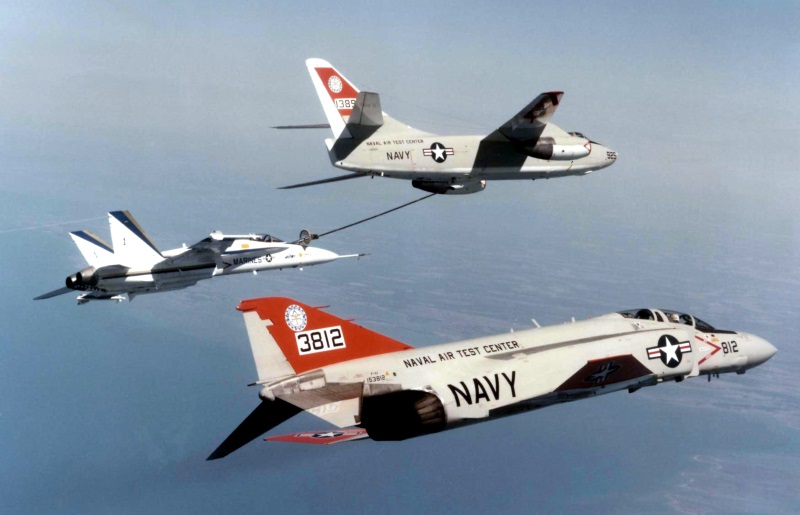
The sniping didn't go away during development and test, particularly because unit cost of the aircraft continued to rise steadily. The cost increase was unsurprising: the late 1970s was a period of historically high inflation in the US, and everything was getting more expensive rapidly. Problems encountered with the machine during the flight test program, such as excessive wing flexing, were played up by the Hornet's enemies, even though to an extent problems are expected in test programs: if they weren't, there would be no inclination to test.
However, the design did have its limitations. The increase in weight meant it was less agile than the YF-17 -- but that was generally a shrug, since the YF-17 had been a "hot rod", lacking kit for serious combat service. Unfortunately, weight had grown more than expected, and most significantly the F-18's range was about 8% less than required by specification. Critics would hammer heavily on the Hornet's range limitations.
The program went ahead since there really wasn't any alternative. The Navy's A-7s and F-4s were wearing out and had to be replaced soon, and if the Hornet program got the axe, the Navy would have to start over again, probably by selecting a modification of an existing machine that would likely be even less satisfactory to their requirements.
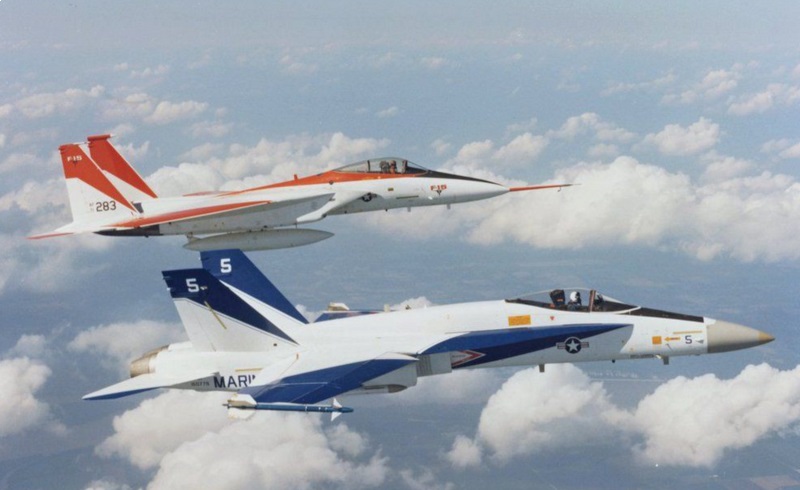
* Initial delivery of production single-seaters began in May 1980. The initial production machines were used for training and evaluation, with the first marked "NAVY" on one side and "MARINES" on the other. By this time, the type was known as the "F/A-18A", since it had been realized that one variant could perform both air combat and strike missions. The pre-production single-seaters have sometimes been referred to retroactively using the designation of "YF/A-18A". The two-seaters were originally designated "TF-18A", but the variant would go into production as the "F/A-18B".
The first line squadron, US Marines VMFA-314 "Black Knights", was declared operational on 7 January 1983. Through the 1980s, Hornet squadrons would multiply until the aircraft was the most common Navy and Marine combat jet. As has been mentioned and is discussed in more detail later, MDD even sold fair numbers of the Hornet to foreign users. The foreign sales effort proved extremely frustrating to Northrop, which had been trying to sell the F-18L land-based version on the foreign market. Since it lacked carrier landing kit, the F-18L was lighter and had better performance than the F/A-18, but nobody wanted it.
The fact that Northrop designed an aircraft that somebody else would build and sell seems like something of an injustice. Northrop certainly felt so and initiated lawsuits against MDD in 1979, but the two companies had signed an agreement; in the end Northrop was stuck with it, and had to settle for being a major subcontractor for an MDD program.
BACK_TO_TOP* As it emerged, the F/A-18A Hornet had a dartlike fuselage, with the pilot in a bubble canopy with a good all-round field of view, and featured twin shoulder-mounted wedge-shaped wings with very long curved LERX; twin outward-canted tailfins; all-moving tailplanes; and twin General Electric F404-GE-400 afterburning bypass jets, arranged side-by-side in the rear fuselage with the inlets just forward of the leading edge of the wing root. About half of the aircraft by weight was aircraft aluminum, the other constituents being about 17% steel, 13% titanium, and 10% GRP.
The two engines were toed out slightly, meaning the inlets were wider apart than the exhausts. The F404 was designed for reliability, simplicity, and serviceability, at the expense of an absolute focus on performance. It was still a powerful engine, providing 61.2 kN (7,256 kgp / 16,000 lbf) afterburning thrust. An automatic fire extinguishing system was fitted between the engines.
The flight surface arrangement was much the same as it was for the YF-17, except that all the flight surfaces were larger, with the wings about 14% larger in total area. The wings featured ailerons outboard and flaps inboard on the trailing edge, as well as leading-edge flaps. The outer wing panels had a power fold that rotated them up through 100 degrees for carrier storage. Most of the slots in the LERXes were filled in during prototype evaluation since they caused excessive drag, though one slot was retained behind the engine inlet. Early prototypes also had a "dogtooth" on the leading edge of the wing, but it was eliminated in production aircraft. As with the YF-17, there was an airbrake between the tailfins, but the strakes alongside the nose featured in the YF-17 were not fitted to the Hornet. All the flight control surfaces were driven by a dual hydraulic system.
The engine intakes had a simple fixed D-configuration intakes and splitter plates. A more sophisticated inlet scheme was not required since the Navy did not specify Mach 2 performance -- a somewhat surprising change in mindset, given that such a speed would have been almost mandatory for such an aircraft two decades earlier. However, the Navy had come to realize that the quest for raw speed had turned out to be something of an illusion: it was almost never achieved by an aircraft carrying any realistic stores load, and was usually not needed in practice anyway.
The F/A-18A had heavy-duty tricycle landing gear, with the nose gear featuring two wheels plus a catapult attachment and retracting forward, and single wheel heavy-duty main gear that retracted inward and to the rear. There was a stinger-type arresting hook between the engine exhausts.
The pilot got into the F/A-18A using a built-in ladder that retracted into the left LERX, and sat on a Martin Baker Mark 10 (SJU-5/A) ejection seat under a single-piece clamshell canopy that hinged on the rear. The control layout featured three Kaiser monochrome CRT multifunction displays (MFDs); a HUD; and "hands on throttle and stick (HOTAS)" controls. The Hornet's cockpit layout was leading-edge technology at the time, and the F/A-18A was also one of the first production aircraft to have a digital fly-by-wire (FBW) control system.
The F/A-18A's primary sensor was the Hughes AN/APG-65 liquid-cooled multimode radar, with modes for strike, air combat, and navigation. Defensive systems included an AN/ALR-50 radar warning receiver (RWR), AN/ALE-39 chaff-flare dispensers, and an AN/ALQ-126B deception jammer. Other avionics included a Litton AN/ASN-130 INS, an AN/APX-100 IFF unit, UHF radio, and a TACAN beacon-navigation receiver.

Built-in armament consisted of a single GE M61A1 Vulcan 20-millimeter six-barrel Gatling cannon set into the top of the nose, with 560 rounds of ammunition in a drum under the cannon and behind the radar. The Vulcan had selectable firing rates of 4,000 or 6,000 rounds per minute. The cannon mounting system was carefully designed to prevent vibration from the cannon from damaging the radar. The mounting position and a deflector system sent most of the muzzle gas over the top of the LERX, preventing it from being sucked into the engine inlets, where it might cause an engine stall. Night blindness due to muzzle flash was not a problem. The cannon installation was modular and could be pulled out as a unit that included the ammunition storage drum.
There was a launch rail for a single Sidewinder or similar AAM on each wingtip; two stores pylons under each wing; a recess under the "corner" of each nacelle for a single Sparrow or similar AAM; and a centerline stores pylon, for a total of nine stores attachments. Initially, Hornets carried the AIM-9L "all aspect" version of the Sidewinder, but moved up in the mid-1980s to the AIM-9M variant, with a better seeker and improved aerodynamics. Similarly, Hornets originally carried the AIM-7F version of the Sparrow, but moved up in the mid-1980s to the AIM-7M, with a much improved seeker.
The Hornet could carry a wide range of stores, with a total external load of 7,030 kilograms (15,500 pounds). For an air-superiority mission, Hornet armament configurations included:
Ground attack stores included:
Tactical nuclear weapons were also possible stores. External 1,250 liter (330 US gallon) fuel tanks could be carried on the centerline pylon and the inner stores pylon on each wing, complementing the fighter's internal fuel capacity of 6,060 liters (1,599 US gallons), most of which was stored under the aircraft's bulged spine, though there were tanks in the inboard wings. There was also a retractable flight refueling probe in the right side of the nose. The Hornet could operate as a tanker, carrying a buddy refueling pack.
The Hornet could carry jamming pods on the underwing pylons for self-defense, as well as targeting and navigation pods of various types in the engine nacelle recesses. The Hornet was designed from the outset to carry such gear, with the pods including:
The F/A-18A had 268 access panels, 238 of which could be reached without use of a ladder or work platform. Over half the panels had quick-release latches, while most of the rest only had about three or four fasteners.
* The two-seat F/A-18B was almost identical to the F/A-18A, except for the addition of the second seat back in the fuselage. Both crew sat on Martin Baker Mark 10 (SJU-6A) ejection seats. Of course, there were dual controls. The two crew sat under a single-piece clamshell canopy that hinged open at the rear. The F/A-18B was fully combat-capable. External dimensions were the same as for the F/A-18A, with the second seat installed by sacrificing about 6% of the internal fuel supply; some of the avionics modules had to be relocated as well.
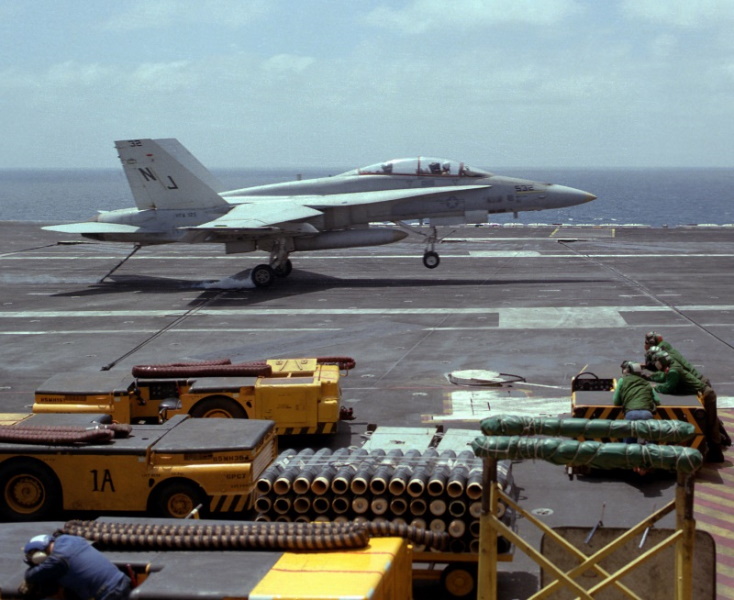
There was consideration for building a dedicated reconnaissance variant of the Hornet, with a modified nose that replaced the Vulcan cannon with cameras and sensors. A single RF-18, or more properly "F/A-18(R)", was built by upgrade of an F/A-18B, performing its initial flight on 15 August 1984. This experiment didn't result in a production reconnaissance Hornet, though the matter didn't go away.
* Although the Hornet-bashers claimed the F/A-18A/B initially proved unsatisfactory in service, the Hornet-boosters shot back that the Navy and Marines were very happy with the type from the outset. It handled nicely, and it was a rugged, reliable aircraft, easy and cheap to maintain and keep flying. Its lightweight fighter origins made it agile, superior to the F-16 in terms of turn radius and high-AOA maneuvers, though inferior in terms of roll rate. In a series of tests against the F-14, the Hornet was able to consistently outmaneuver the big Tomcat. One Marine pilot boasted of taking on a MiG-23 flown by the USAF, and flying rings around it -- though it must be acknowledged the MiG-23 was not noted for its agility.
The range issue did remain troublesome. A Navy evaluation concluded that the Hornet didn't have the range-payload capability of the A-7, but MDD protested that the evaluation was based on unfair assumptions, and a comparable Marine evaluation gave the Hornet a clean bill of health. Some Hornet pilots conceded that its range was marginally inferior to that of the A-7, but added that they'd take the Hornet over the A-7 any day: the Hornet was a far more accurate strike platform and much more able to take care of itself, due to its agility and higher performance. Trying to sort out the claims and counterclaims is much along the lines of trying to sort out a lawsuit, and about as interesting.
The Hornet saw its first combat action during Operation EL DORADO CANYON in April 1986, when the US launched a well-coordinated multiservice air strike against Libya in response to a Libyan-sponsored bombing of a Berlin nightclub frequented by US military personnel. Two Navy and two Marine Hornet squadrons were committed to the strike, mostly in the defense suppression role, firing AGM-88 HARM missiles against Libyan radar stations.
* A total of 371 F/A-18As and 40 F/A-18Bs was built up to 1987, when production switched to the F/A-18C/D series, described below. F/A-18Bs served almost entirely in the operational conversion training role.
Hornets were generally painted in a two-tone light gray air-superiority color scheme. However, F/A-18As were used by US Navy aggressor training squadrons, painted in vivid camouflage color schemes matching those of Russian aircraft. The performance and agility of the Hornet, particularly when carrying a minimal warload, made it useful for aggressor training, though the fact that it was normally the same machine as those that it was flying against reduced its value somewhat, since it wasn't a "dissimilar" type.
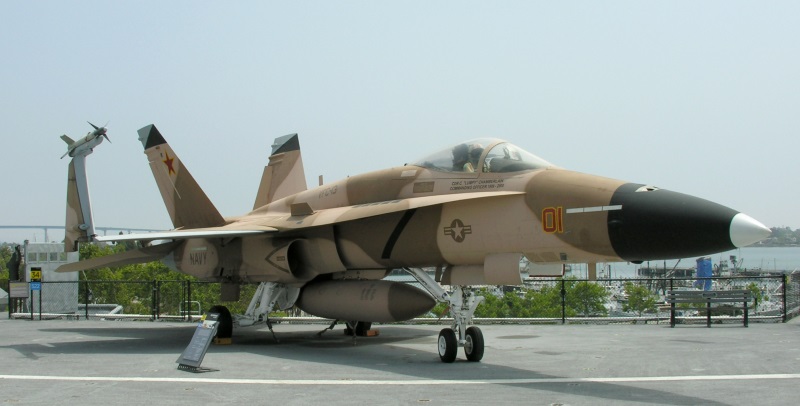
The US Navy Blue Angels flight demonstration team adopted the F/A-18A in 1986. These machines were stripped of some gear, such as the Vulcan cannon, to improve performance and reduce maintenance overhead, and fitted with smoke generators. The US National Aeronautics & Space Administration (NASA) also used a number of F/A-18As on loan from the Navy for flight research, and as chase planes.
BACK_TO_TOP* As mentioned, the F/A-18A/B was replaced in production by the single-seat "F/A-18C" and two-seat "F/A-18D" variants in 1987. The F/A-18C and F/A-18D were difficult to distinguish from their predecessors, the changes being mostly internal. One external innovation was the addition in all but initial production of a prominent strake on top of the rear of each LERX to improve airflow over the tailfins in high-AOA flight. However, the strakes were a worthless recognition feature, since they were retrofitted to F/A-18A/B machines.
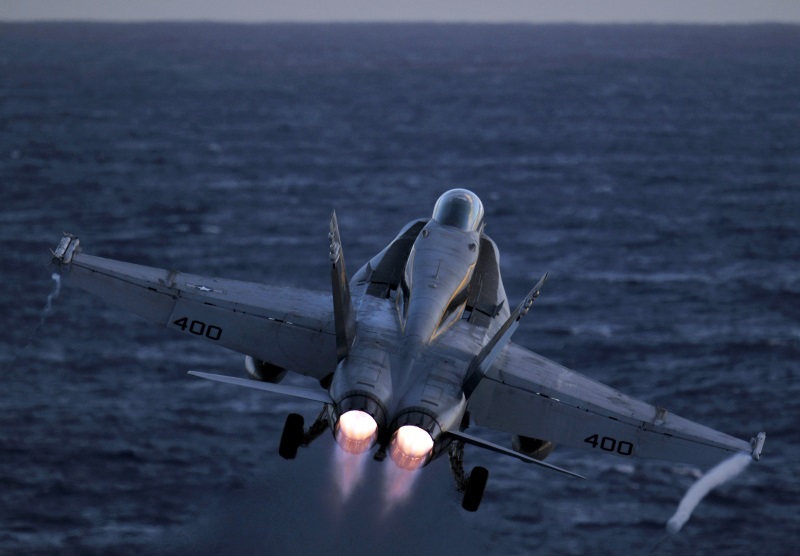
Initial flight of the F/A-18C was on 3 September 1986, with test pilot Glenn Larson at the controls. The prototype was an updated F/A-18A and not a new-build aircraft. Initial production F/A-18Cs featured:
The F/A-18D was, not surprisingly, a two-seat F/A-18B with the same upgrades as the F/A-18C.
___________________________________________________________________
MCDONNELL DOUGLAS F/A-18C HORNET:
___________________________________________________________________
wingspan with AAMs:
12.31 meters (40 feet 5 inches)
wingspan (folded):
8.38 meters (27 feet 6 inches)
wing area:
37.16 sq_meters (400 sq_feet)
length:
17.07 meters (56 feet)
height:
4.66 meters (15 feet 4 inches)
empty weight:
10,455 kilograms (23,050 pounds)
MTO weight:
25,400 kilograms (56,000 pounds)
max speed at altitude:
1,915 KPH (1,190 MPH / 1,033 KT)
service ceiling:
15,250 meters (50,000 feet)
take-off run at MTOW:
425 meters (1,400 feet)
ferry range:
3,335 kilometers (2,075 MI / 1,800 NMI)
combat radius:
1,065 kilometers (660 MI / 575 NMI)
___________________________________________________________________
* The F/A-18C/D was really only a half-step forward. After turning out 137 F/A-18Cs, production rolled to a "Night Attack" AKA "Lot 12" subvariant, also known as the "F/A-18C+", with the first delivery on 1 November 1989. Similarly, after the delivery of 31 F/A-18Ds, production was rolled to a night attack F/A-18D, originally the "F/A-18D+" with the same capabilities as the Night Attack F/A-18C.
The Night Attack Hornet was the full step forward from the F/A-18A/B, featuring a cockpit redesigned for night vision goggle (NVG) compatibility; color MFDs -- actually monochrome CRTs with LCD shutters that provided limited color capability; and a digital moving map capability, replacing the original film-based system.
The Night Attack Hornet carried the same navigation and targeting pods as the F/A-18A/B, but received a significant upgrade in capability when the improved AN/AAS-38A pod was introduced in 1991, providing a badly-needed laser target designation capability. It was followed in 1996 by the AN/AAS-38B, with an "autotracking" feature added to its laser spot tracking capability that helped the aircrew stay locked on to a designated target.
Hornet pilots felt the Night Attack Hornet was the first Hornet to provide true all-weather, day-night strike capability. The Marines were particularly enthusiastic about the updated F/A-18D, since the workload for night attack missions was better handled by two crew. Rear-cockpit flight controls were removed from USMC machines, and the back-seater was given hand controls for targeting systems. The Marines liked to use the two-seaters for the "fast FAC (forward air control)" role, with the back-seater identifying targets with sensor pods and marking them with a laser designator, or with the aircrew firing unguided smoke rockets.
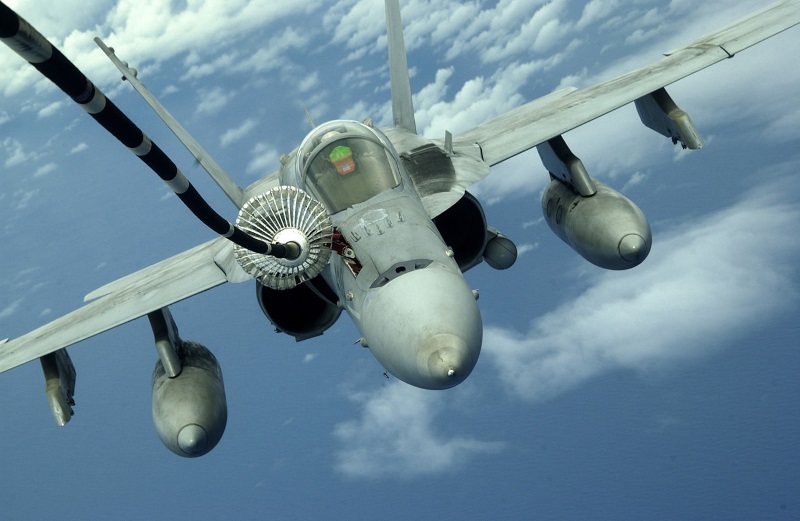
* The Night Attack Hornet wasn't the end of the story. F/A-18C/Ds received a number of other upgrades in the 1990s, some of them significant:
Other enhancements were implementation of a degree of "stealth" through application of "radar absorbing material (RAM)" in key locations; and a new, lighter, stronger internal fuel tank scheme.
Following up the experiments with the F/A-18(R) reconnaissance variant of the Hornet in the 1980s, in the early 1990s the US Marines wanted to adopt a reconnaissance Hornet, the "F/A-18D(RC)", which would have carried the latest digital electro-optic sensors. Through various fits and starts, this did happen, with the US Marines obtaining a dozen F/A-18Ds modified to the F/A-18(RC) configuration by the installation of the "Advanced Tactical Airborne Reconnaissance System (ATARS)" in the nose, replacing the Vulcan cannon -- these machines also carrying a centerline datalink pod to relay reconnaissance data to other nodes. Initial operational use of the F/A-18(RC) took place in 2000, over the Balkans. Dozens more F/A-18Ds were modified to permit installation of ATARS, but only a limited number of ATARS kits were obtained.
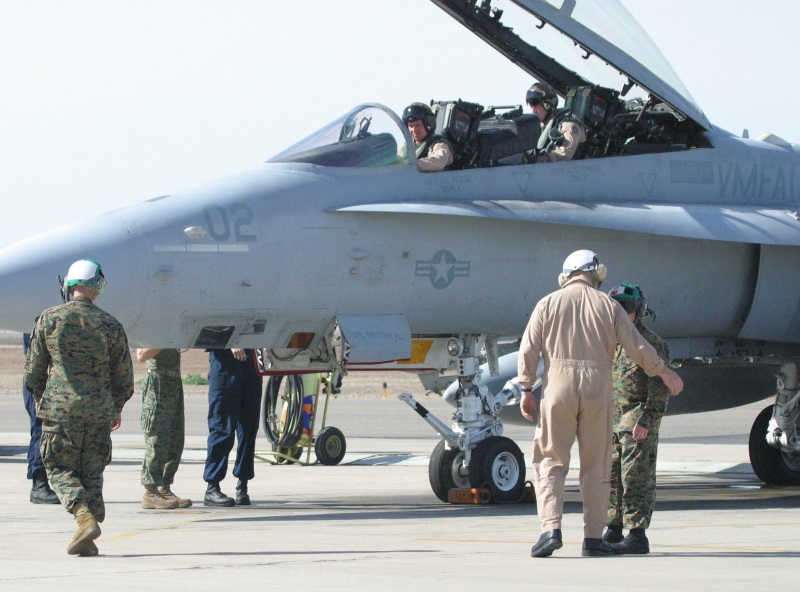
* The Hornet returned to combat in 1991 during Operation DESERT STORM, the offensive intended to evict the Iraqis from Kuwait. The Hornet flew large numbers of strike missions. In one incident, two Hornets carrying a heavy bombload were jumped by two Iraqi MiG-21 fighters; the Hornets shot down their two attackers without bothering to dump their bombload, then went on with their strike mission.
The Hornet often served in the "dirty little wars" that became something of the norm in the 1990s, performing flights over the Balkans, as well as the no-fly zones in Iraq. Once again, in spite of the critics, the Navy praised the usefulness and capability of the Hornet. It served in the 2001:2002 intervention in Afghanistan and in the US invasion of Iraq in 2003. One F/A-18C was accidentally shot down by a US Patriot surface-to-air missile during the Iraq invasion, the pilot being killed.
The Navy and Marine Corps obtained a total of 466 F/A-18Cs and 161 F/A-18Ds. The F/A-18C/D was a particular step forward since it gave the Navy a true multirole capability. That was not only important in simplifying procurement and logistics, it also meant that the Navy could optimize sortie rates for any particular mission, since all the combat aircraft available could do the mission. The F/A-18C/D was so much of a step up from the F/A-18A/B that the F/A-18A/Bs were shunted off to secondary roles as fast as possible.

* However, plenty of F/A-18A/B machines remained in service with the Navy Reserve and the Marines, and to keep these aircraft useful, an upgrade program was initiated in 1995. There were actually two separate programs or "engineering change proposals (ECPs)", one for the Navy Reserves, designated "ECP 560"; and the other for the US Marines, designated "ECP 583". Not all Navy Reserve and Marine F/A-18A/Bs were upgraded, with preference sensibly given to airframes with relatively low flight hours.
Both programs involved fit of improved processors and cockpit displays; GPS navigation capability; support for modern targeting pods, such as the Northrop Grumman / Rafael Litening AT pod; and support for AMRAAM. The most significant difference between the two efforts was that the Navy upgrade retained the old AN/APG-65 radar, adding modifications to permit it to support AMRAAM, while the Marine aircraft got the new AN/APG-73 radar. The Marine upgrade also added an AN/ARC-111 CIT advanced IFF system. Following a development program, formal upgrades began in 2000.
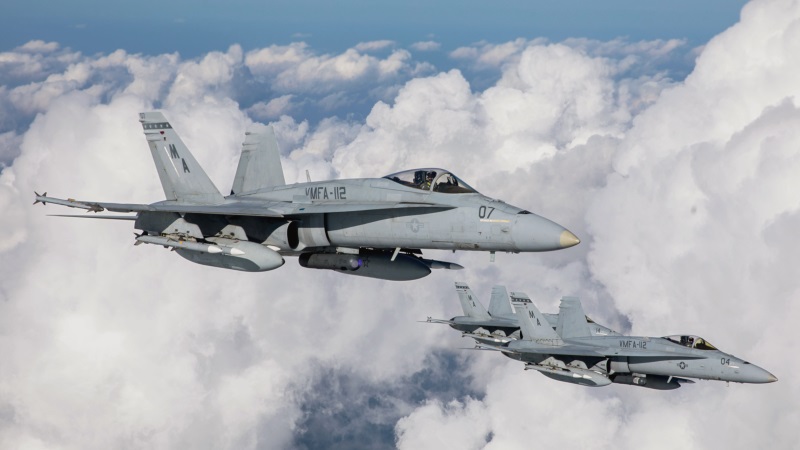
The Marines have implemented a second-phase upgrade program for their F/A-18A/Bs, which features addition of AN/ALE-47 chaff-flare dispensers; the Joint Helmet-Mounted Cueing System (JHMCS) to support the AIM-9X off-boresight Sidewinder AAM; improved cockpit displays, with a digital map display system; and the Multifunctional Information Distribution System (MIDS / Link 16) datalink. Link 16 permits sharing data between aircraft and other platforms, and provides two secure voice channels as well.
This second-phase upgrade effort was implemented as a collaboration with Canada, as discussed below. An airframe "service life extension program (SLEP)" for the Hornets has also been implemented, with the first machine re-delivered to the USMC in early 2016. The Navy machines were not given a SLEP, since they are to be retired from 2017 to 2020, with 136 going to the "boneyard" at Davis-Monthan AFB in Arizona, to be used as spares hulks.
The last operational deployment of Navy Hornets was in late 2018. The Marines want to keep the Hornet flying until at least 2030; the Navy will pass on their Hornets in the best condition to the USMC. A handful have also been passed on to NASA. In the meantime, Marine Hornets still have a future; in 2019, Raytheon got a contract to upgrade 98 USMC Hornets to an AN/APG-79(V)4 "active electronically scanned array (AESA)" radar -- more on this technology later -- with the upgrades to take place from 2020 through 2022.
BACK_TO_TOP* The Hornet proved successful in export service. Three nations, including Canada, Australia, and Spain obtained the F/A-18A/B.
Canada was the first to buy the Hornet, obtaining 98 "CF-18A" single-seaters and 40 "CF-18B" two-seaters, with deliveries from 1982 to 1988. They were also known in Canadian service by the alternative designations of "CF-188A" and "CF-188B" respectively, there being some subtle distinction in the usage of the two sets of designations. They were not formally referred to as "Hornets", since Canada is a bilingual country and "Hornet" in French is "Frelon", inviting confusion with the Aerospatiale Frelon helicopter. However, the name "Hornet" is retained here for Canadian aircraft for the sake of simplicity.
The Hornets were obtained to replace the McDonnell F-101 Voodoo for national air defense and the Lockheed F-104 Starfighter to help maintain European commitments, though the Canadians would give up their European air presence in the 1990s following the end of the Cold War. The Canadians evaluated both the F-16 and the F/A-18 and decided the Hornet was the better deal, which MDD no doubt saw as a gratifying snub to the Hornet-bashers.
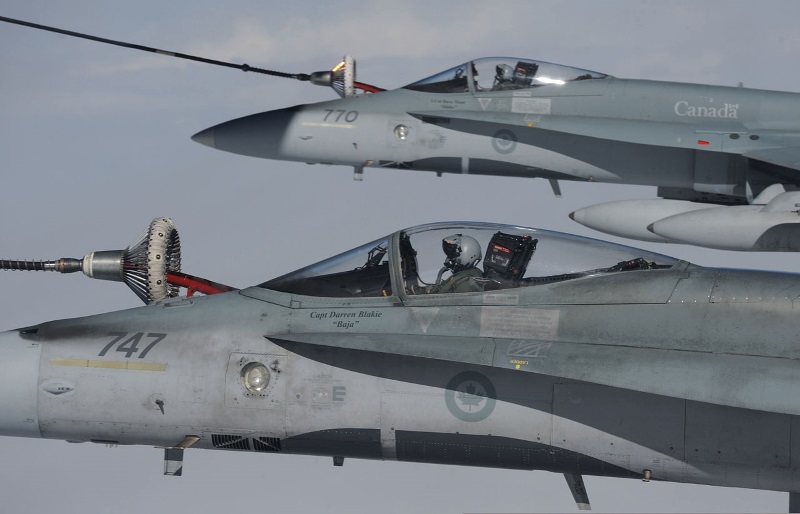
The Hornets were delivered almost as stock F/A-18A/Bs, differing mostly in having a spotlight on the left side of the nose for identifying intruders on night intercepts; an instrument landing system (ILS) receiver replacing the automatic carrier landing system; a cold-weather survival kit; and the capability to carry Canadian CRV-70 unguided rocket pods and British BL755 cluster munitions. The Canadians also acquired a 1,820-liter (480 US gallon) long-range external tank, which was not adopted by the US Navy and Marine Corps since it wouldn't fit on the centerline pylon.
The Canadians were ahead of other Hornet operators in qualifying women to fly the type. Although funding cutbacks have reduced the size of the Canadian Hornet fleet, with machines being retired from service and rotated through storage, in the late 1990s, an upgrade program similar to that implemented for US Navy Reserve and Marine F/A-18A/B Hornets was initiated, with Canadian Hornets receiving the AN/APG-73 radar, an improved processor, new radios and IFF, a GPS-INS navigation system, and AMRAAM capability. The first upgraded CF-18 was redelivered in 2003, with the phase 1 program completed in 2006.
As mentioned, Canada collaborated with the US Marines on a follow-on upgrade program, and Canadian Hornets received the same second-phase updates as USMC Hornets, including AN/ALE-47 chaff-flare dispensers; the JHMCS helmet-mounted sight; improved cockpit displays; and the MIDS Link-16 datalink. The Canadian phase 2 program was completed in 2010, with 79 machines updated in all.
Canadian Hornets flew in the First Gulf War, performing substantial numbers of strike sorties, and also participated in the Balkan interventions of the 1990s. The CF-18s conducted strikes in the Libyan intervention of 2011, and also saw combat action against Islamic State insurgents in Syria and Iraq in 2014 and 2015. The Canadians were planning on replacing the CF-18 with the Lockheed Martin F-35 -- but the F-35's cost spiraled out of control, leading the government in Ottawa to cancel the buy.

Canada then decided to obtain the Boeing Super Hornet, discussed later -- but Boeing decided to begin a trade dispute with airliner manufacturer Bombardier of Canada, with Ottawa then angrily dropping the Boeing buy. The trade dispute fizzled out, but the Canadians ended up being wary of Boeing, and for the moment Canada's next-generation fighter program is in an uncertain state.
That being the case, in 2017 Canada decided to buy 25 Hornets being retired by Australia as stopgaps, these aircraft being delivered in 2019:2021. Also as mentioned above, the Canadians are upgrading their Hornets with the same upgrade package as adopted by the US Marines, including the AESA radar, to keep them in service until a next-generation fighter can be obtained -- whenever that will be.
* Australia obtained a total of 57 "AF-18A" single-seat and 18 "ATF-18A" two-seat machines from 1985 through 1990. The first two were flown in from the USA; all the rest were produced locally by ASTA, originally from knockdown kits but with increasing local content. They replaced the Dassault Mirage IIIO in service. They were basically F/A-18A/Bs, lacking catapult attachment and arresting hook, and fitted with an ILS in place of the automatic carrier landing system plus an Australian-specified HF radio. As with Canadian Hornets, Aussie Hornets were qualified for the CRV-7 rocket pod.
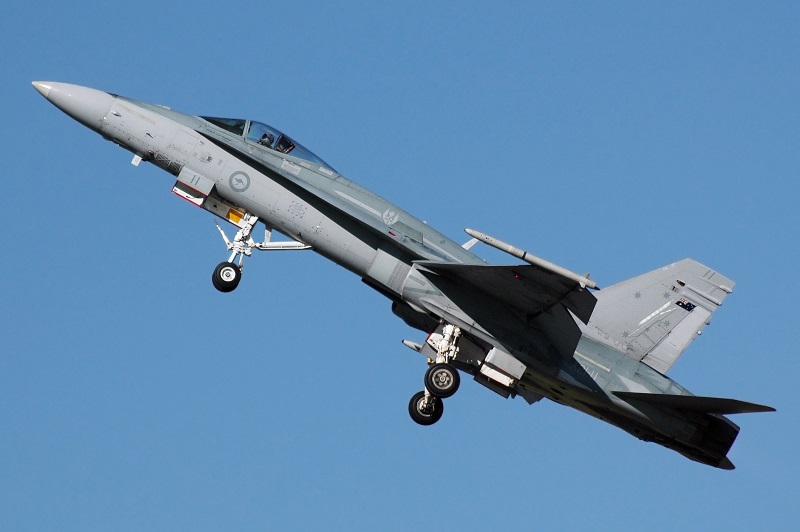
An upgrade program was implemented for Australian Hornets in the late 1990s. This effort provided new kit more or less comparable to that received by US Marine F/A-18A/Bs in their two-phase upgrade program, including new processors, displays, and communications; AN/APG-73 radar; AMRAAM support; a new countermeasures suite, including Saab BOL chaff-flare dispensers; and JHMCS sight support. Aussie Hornets used JHMCS with the British Advanced Short Range AAM (ASRAAM), not the AIM-9X Sidewinder.
In 2005, the Australians also purchased a batch of Northrop Grumman / Rafael Litening AT targeting pods for their Hornets, with the pods entering service in 2007. From 2008, improved countermeasures systems were fitted -- including an AN/ALR-67(V)3 RWR and the Israeli Elbit EL/L-8222 jammer pod. The jammer pod was carried on a fuselage station; it was not actually obtained for the Hornet, instead being purchased for Australia's F-111 Aardvark fleet, but the F-111s were retired ahead of time, leaving the jammer pods otherwise unused.
The first combat deployment of Aussie Hornets was in 2003, performing air strikes in support of the Anglo-American invasion of Iraq; from 2015 to 2017, they participated in strikes on Islamic State insurgents in Syria and Iraq. The Aussie Hornets have now all been retired; as noted earlier, 25 were sold to Canada. The Australians cut a deal to sell the rest to RAVN Aerospace -- an American firm that flies combat jets for hire as "adversary / aggressor" training -- but so far nothing much has happened, and there's talk of transferring them to Ukraine to support the war effort there. It hasn't gone beyond talk at last notice.
* Spain's air force, the Ejercito del Aire (EdA), obtained 60 "EF-18A" single-seat and 12 "EF-18B" two-seat machines from 1986 to 1990, replacing F-4s, F-5s, and Mirages. Once again, the Hornet was chosen in favor of the F-16. Spanish Hornets were given the designations of "C.15" and "CE.15" respectively. Spain also acquired 24 ex-US Navy F/A-18As in 1995 and 2000, bringing the total to 96, the 24 being the first "hand-me-down" Hornets provided to a foreign user. The single-seaters and two-seaters were designated "C.15" and "CE-15" respectively in Spanish service.
Spanish Hornets participated in air actions over the Balkans in the 1990s. 71 Spanish Hornets were given an upgrade from 1992 to 1995 to bring them up to "EF-18+" standard, generally equivalent to the F/A-18C/D spec, with 46 upgrades performed by McDonnell Douglas and 25 by EADS-CASA in Spain. The upgrade provided the AN/APG-73 radar and AMRAAM compatibility; new processors and software; new wiring and pylon mods; and carriage of the Nite Hawk FLIR pod. Later, the Spanish would acquire the Israeli Rafael Litening pod instead, as well as the Rafael Reccelite reconnaissance pod, and also acquire the Diehl IRIS-T short-range heat-seeking AAM.
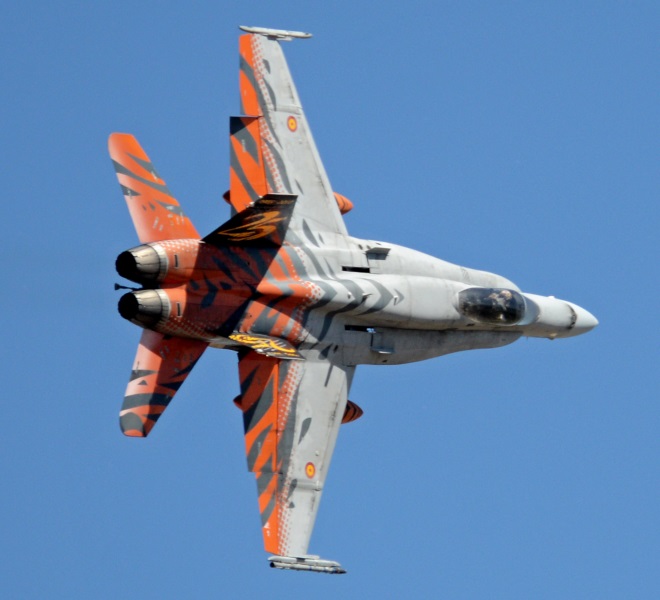
A program was initiated in 2000 to put 67 of the EdA Hornets through a "mid-life update (MLU)", featuring avionics enhancements such as a new tactical computer; new cockpit color displays; new communications, including Have Quick II radios; a cockpit layout compatible with NVGs; and other avionics updates. The last of the updates was redelivered in 2009. The MLU machines are known as "EF-18Ms", being designated in EdA service as"C.15M" and "CE.15M". They have since received further updates, including a new countermeasures suite, and the Thales Scorpion helmet-mounted sight. The Spanish Hornets are scheduled to be retired around 2030, being replaced by the Eurofighter Typhoon.
* Later export sales were, not surprisingly, of the F/A-18C/D variant, being ordered by Kuwait, Switzerland, Finland, and Malaysia. In September 1988, Kuwait ordered 32 "KAF-18C" single-seat machines and 8 "KAF-18D" two-seat machines. None were delivered until 1992, after the Gulf War, with deliveries completed by late 1993. These machines featured F404-GE-402 EPE engines and night attack features, but retained the AN/APG-65 radar. Harpoon and Maverick missiles were supplied with the deal, though the Kuwaitis didn't get AMRAAM and had to make do with the AIM-7F Sparrow.
The Kuwaiti Hornets replaced Douglas A-4 Skyhawks and Dassault Mirage F-1s. These Hornets were painted in a three-color (light sand / light blue / light gray) disruptive camouflage pattern. In 2018, Kuwait initiated an upgrade program with Boeing, with the updated Hornets to get a new countermeasures suite, with a towed jammer, and also the latest smart munitions. The upgrade was completed in 2021. They are to be replaced with the Eurofighter Typhoon and the Super Hornet.
* The Swiss ordered 26 F/A-18Cs and 8 F/A-18Ds in June 1993, with these machines replacing the Dassault Mirage III. Competitors included the F-16, the SAAB Gripen, and the Dassault Mirage 2000-5. The buy was heavily contested, the selection of the Hornet having originally been made in 1988 -- only to be challenged by Dassault, with the challenge leading to re-opening the competition in 1990. The buy ultimately had to be approved by a national public referendum.
This was another important sale for MDD, since the Swiss buy aircraft for the long term and give them a very close looking-over before closing a deal. Winning in the face of such determined opposition was even more satisfying. The Mirage 2000-5 might have been thought to have an edge since it was a logical follow-on to Swiss Mirage IIIs, which had proven very satisfactory in service. However, surprisingly the carrier-based features of the Hornet were a plus in the deal, since the Swiss operate from airfields in tight mountain valleys where good approach characteristics are handy, and also store aircraft in mountainside caves, making the folding wings very useful.
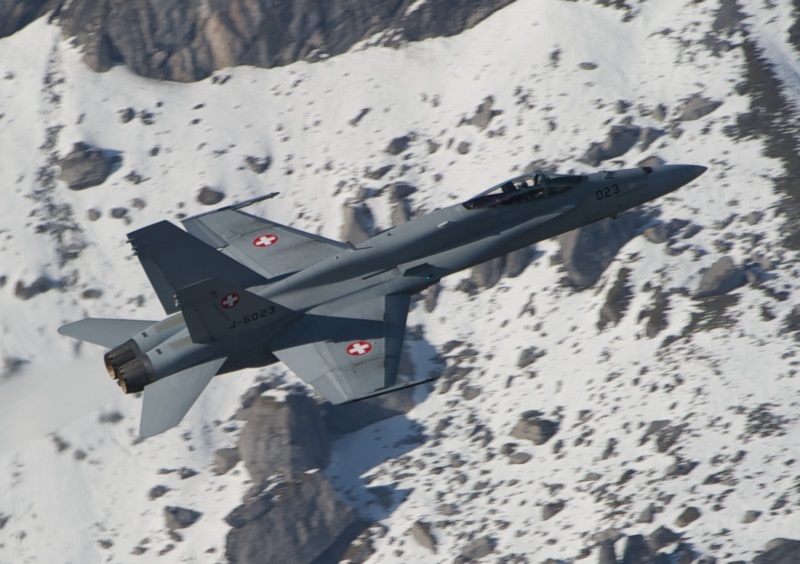
Deliveries began in 1996. Only the first two were delivered directly from the MDD plant in Saint Louis. All the rest were provided as knockdown kits to the Swiss Federal Aircraft Company (F+W) in Emmen and assembled there. That didn't save the Swiss government any money, but it kept some of the money in Switzerland, and gave F+W experience in dealing with an advanced combat aircraft. The deal also included a contract for F+W to provide a limited run of aileron and aileron shrouds to MDD for Hornet production. Swiss machines featured F404-GE-402 EPE engines -- in fact, this engine variant was developed specifically for this deal, since the Swiss had concerns over the Hornet's acceleration and rate of climb -- and AN/APG-73 radar.
Swiss Hornets were put through an "Upgrade 21" by RUAG from 2004 to 2009 to keep them up-to-date, with an "Upgrade 25" conducted from 2021, providing such improvements as the JHMCS, new cockpit displays, improved IFF, and other operational avionics. The Swiss committed to obtaining the F-35 in 2021, with the first F-35s to arrive in 2025 and Swiss Hornets to be out of service by 2030.
* Finland ordered 57 F/A-18Cs and 7 F/A-18Ds in May 1992, with the Hornet competing against the Russian Mikoyan MiG-29. All the two-seaters were built in Saint Louis, with initial deliveries in 1995. All the single-seaters were assembled by Valmet from knockdown kits. Finnish machines featured the AN/APG-73 radar and were assigned the air combat role, carrying the AIM-9M Sidewinder and AMRAAM.
The Hornet, as a carrier-based aircraft, was seen as well-suited to the Finnish practice of "base dispersal" -- in which, in a crisis, combat aircraft are dispersed to camouflaged pre-prepared "road bases" in the forests, with the aircraft operating off of reinforced sections of civil roadway. Finnish pilots often fly operations off of road bases as part of training exercises; it can be tricky because the roads are narrow, flanked by obstructions, and poorly illuminated at night. The landings are made with arresting gear, much like carrier landings.
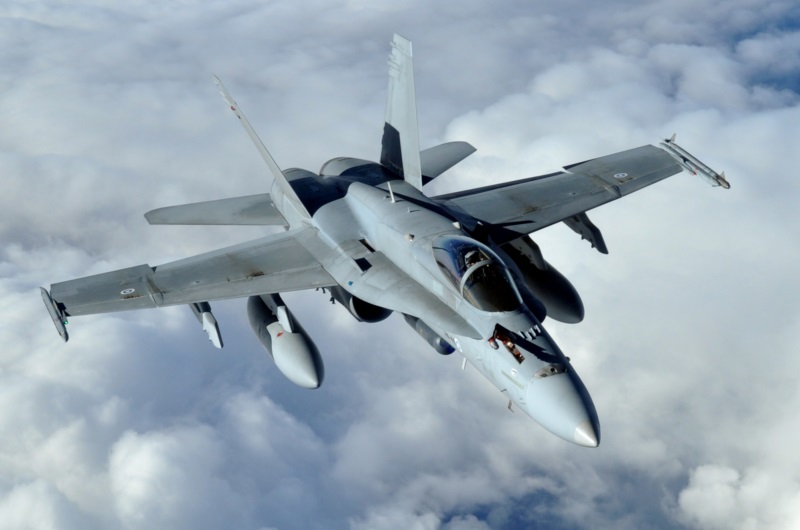
The Finns initiated a mid-life upgrade program for their Hornets in 2007 in two phases, with the first phase completed in 2010 and the second phase completed in 2016. The fully updated Hornets had advanced cockpit avionics, including a helmet-mounted sight and NATO-interoperable datalinking; improved countermeasures; and carriage capability for modernized offensive stores. In 2021, the Finns decided to obtain the F-35 to replace their Hornets, with the Hornets to be retired by 2030.
* Malaysia obtained 8 F/A-18Ds in the late 1990s. They were the only user to not obtain any single-seaters. They bought a batch of MiG-29s at the same time for the air superiority role -- sticker price of the MiGs was about half that of the F/A-18D -- and assigned the F/A-18Ds the strike role. Deliveries of Malaysia's Hornets were in 1996 and 1997. These machines featured the AN/APG-73 radar. From 2011, the Malaysian Hornet fleet was upgraded with modernized avionics, including the JHMCS helmet-mounted sight. Malaysian Hornets saw action in 2013, in strikes on insurgents in Borneo.
Thailand came very close to buying a batch of four F/A-18Cs and four F/A-18Ds, but finally decided to buy refurbished ex-USAF F-16s instead. The Thai Hornets were already in an early production phase when the deal was canned and they were purchased for the USMC, with all eight configured as F/A-18Ds. South Korea and Singapore also strongly considered the Hornet, but ended up buying the F-16 as well.
Interestingly, except for Kuwait, it appears that all other foreign Hornet users retained the overall gray paint scheme of US Navy Hornets. The Malaysians varied slightly from this in using an overall "gun metal gray" color scheme, and the Canadians did paint a "fake canopy" under the nose as a deception measure, a gimmick designed and copyrighted by aviation artist Keith Ferris.
* A total of 1,481 Hornets was built for all users from 1980 to 2000, with the last first-generation Hornet -- one of USMC F/A-18Ds originally intended for Thailand -- accepted for service on 25 August 2000. The list below gives a breakdown of users and variant production:
Some sources give the number of F/A-18As as 595 and of F/A-18Bs as 111. The first-generation Hornets are likely to remain in service for years to come, being given service-life extensions and technical upgrades to keep them flying. With Boeing's acquisition of McDonnell Douglas in the late 1990s, the Hornet became the Boeing Hornet.
BACK_TO_TOP